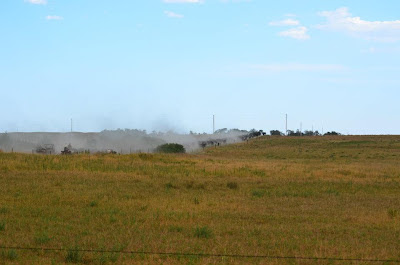Just like with every other mammal in the world wild or domestic there comes a time in the youngs life where the mother will wean them from getting the majority of their nutrition from mothers milk to consuming an Adult like diet. Calves can be safely and effectively weaned from the mothers as early as 45-60 days of age. There is challenges of weaning calves that early and much more care to diet/nutrition, housing, and husbandry practices need to be taken. Not that when weaning an older calf these things can be thrown out the window. Younger calves have different needs than an older calf and we have to take that into consideration when weaning. Typically at our farm we try to wean the calves between 5 and 6 months of age which for us is late September. They will weigh around 500-550 pounds at that point in time. This year due to the lack of rain which resulted in a much lower production in the grasses that inhabit our summer pastures we needed to remove the calves about a month earlier. By removing the calves, there will be more grass for the cows to graze because the calves are not there eating it and the cows feed requirement will decrease due to no longer lactating. The energy requirement of a 1200 pound cow will decrease by about 25-30% by removing the calf at this stage of her production cycle and her daily feed intake will decrease by about 5-8%.
We finished weaning the last group of calves over labor day weekend. On weaning day our schedule looks something like this:
 |
| Coal is ready to get the show on the road with the last group of calves to wean. |
2- head to the pasture and gather the cows and calves into the catch pens
3 - load the calves into the trailers
4 - weight the trailers with calves in them (this is used to determine the average weight of the calves). By knowing what the calves weighed we can make adjustments to their feed needs and know how good (or not good) our cow herd is performing.
5 - "work" the calves (give them their booster vaccine and de-worm them)
6 - move the calves to their new home (the pens by the barn) where fresh feed and water waits for them.
This year due to the "extra" stress that the drought and heat has put on our livestock we also gave our calves a shot of stress fighting minerals to help boost their immune systems and help them stay healthy. We also took an extra week to wean the calves so that there were fewer calves in the weaning pen to help reduce the dust. Normally we put out Availa-4 tubs which are a mineral tub that are high in stress fighting and immune building vitamins and minerals. The tubs are very palatable and tasty to the calves so they will begin to lick on them almost immediately. This year we are using a few more tubs than normal just to help the calves immune system stay strong with the extremely dry and dusty conditions.
 |
| This group had been weaned for a week and has been moved to one of the bigger pens. Day 1 in the big pen and they already know to follow the tractor to the feed bunk!!! |
It was hot, dry and dusty this year during weaning so we have been paying extra attention to the health of the calves and their nutrition to make sure that we get them through this stressful transition from life on the pasture with momma to life in the pens and eating a well balanced diet from the feed bunk.
The calves on the right were weaned about 4 hours before the picture and are exploring their new surroundings.
|





















































